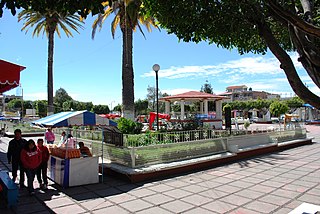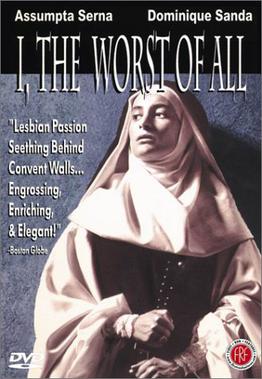
Juana Inés de Asbaje y Ramírez de Santillana, better known as Sor Juana Inés de la Cruz, was a New Spain writer, philosopher, composer and poet of the Baroque period, as well as a Hieronymite nun, nicknamed "The Tenth Muse" and "The Phoenix of America" by her contemporary critics. As a Spanish-criolla from the New Spain, she was among the main American-born contributors to the Spanish Golden Age, alongside Juan Ruiz de Alarcón and Garcilaso de la Vega "el Inca", and is presently considered one of the most important female authors in Spanish language literature and the literature of Mexico.

The University of the Cloister of Sor Juana is a private university located in the former San Jerónimo Convent in the historic center of Mexico City. This convent is best known for having been the home of Sor Juana Inés de la Cruz for over twenty five years, she produced many of her writings here. After the convent was closed in the 19th century, the large complex was divided and was home to a number of institutions and businesses, including a large dance hall in the mid 20th century. In the 1970s, the government expropriated the complex, explored it and began the restoration process. In 1979, the current university was founded at this site and it is currently the benefactor and guardian of the complex. The institution offers bachelors, two masters and two certificates, mostly in the humanities. The institution also sponsors or co-sponsors a number of cultural and educational activities, mostly situated in the historic center of the city.
The Sor Juana Inés de la Cruz Prize is a literary prize awarded to a book written in Spanish by a female author. It is organized by the Guadalajara International Book Fair, based in Guadalajara, Jalisco, Mexico. Current winners of the prize receive USD$10,000.
Margo Glantz Shapiro is a Mexican writer, essayist, critic and academic. She has been a member of the Academia Mexicana de la Lengua since 1995. She is a recipient of the FIL Award.

Ozumba is one of 125 municipalities in the State of Mexico. Its municipal seat is the town of Ozumba de Alzate. It is located in the southeast portion of the Valley of Mexico, 70 km southeast of Mexico City near the Mexico City-Cuautla highway. The main feature of this area is the Parish of the Immaculate Conception which began as a Franciscan monastery in the 16th century. The entrance to the cloister area contains murals related to the early evangelization efforts of this order. They include scenes such as Hernán Cortés greeting the first Franciscan missionaries in Mexico, the martyrdom of some of the first young converts to Christianity and even a scene where the monks are flogging Cortés. The church itself inside has suffered the theft of a number of its antique pieces. The name Ozumba comes from Nahuatl meaning "over the streams of water". "de Alzate" was added to the formal name in honor of the scientist José Antonio Alzate y Ramirez Santillana who was born here.
Soyaniquilpan de Juárez is a municipality in the State of Mexico in Mexico. The municipal seat is San Francisco Soyaniquilpan. The municipality covers an area of 140.77 km².

Guillermo Schmidhuber de la Mora is a Mexican author, playwright, and critic.
Loa to Divine Narcissus is an allegorical play written by the Mexican writer Sor Juana Inés de la Cruz, an important literary figure of the Spanish colonial period. The play was first published in 1689. The work is considered a loa, a short theatrical piece related to the longer auto sacramental. This loa is a commentary on historical events involving indigenous Aztec inhabitants and Spanish colonists. The Divine Narcissus is ambiguous not only because the Spanish do not openly explain their objectives to the native population, but also because the story equates the Christian Eucharist to Aztec sacrifice.
Sor Juana Inés de la Cruz is a Mexican telenovela produced by Televisa and broadcast by Telesistema Mexicano in 1962. It is based on the life of Juana Inés de la Cruz.

I, the Worst of All is an Argentine film directed by María Luisa Bemberg. The film was released in 1990 and is a biopic on the life of Juana Inés de la Cruz. It was based on Octavio Paz's Sor Juana: Or, the Traps of Faith. The film premiered at the 47th Venice International Film Festival where it received the OCIC Award - Honorable Mention. The film was selected as the Argentine entry for the Best Foreign Language Film at the 63rd Academy Awards, but was not accepted as a nominee.
Margarita López Portillo y Pacheco (1914–2006) was a Mexican novelist who earned several awards for her novels and also had three of them adapted for film. She was a public servant, serving under three presidents in various capacities of regulating media. During her brother José López Portillo's (1976-1982) presidency, she received sharp criticism for his nepotism and failure to act on warnings of potential fire at the National Cinema Library. She studied the works of Sister Juana Inés de la Cruz and led an effort to restore the convent where the Sister had lived. In 1980, she was granted the French Order of Arts and Letters.
Yolanda Quijano is a Mexican painter and sculptor whose work has been recognized with membership in the Salón de la Plástica Mexicana.

Juana Inés, is a Mexican television series co-produced by Canal Once and Bravo Films. The series is created by Patricia Arriaga Jordán, based on the life and work of Sor Juana Inés de la Cruz. The series consists of seven episodes and one season. Series production began on November 4, 2015 in the Ex-Hacienda Santa Mónica, in Mexico City. The series was released on 26 March 2016.
María Luisa Manrique de Lara y Gonzaga, Marchioness of la Laguna, 11th Countess of Paredes was by birth member of the House of Gonzaga and Vicereine of New Spain by virtue of marriage.
María Magdalena González Sánchez is a Mexican astrophysicist, nuclear physicist, researcher, and professor best known for her contributions in gamma ray research and for being the head of the High Altitude Water Cherenkov Experiment (HAWC). She has published 90 articles about her field of study in indexed journals. In 2015 she received the Sor Juana Inés de la Cruz Recognition from the National Autonomous University of Mexico (UNAM).
Paloma Villegas is a Mexican writer and translator and winner of the prestigious Sor Juana Inés de la Cruz Prize for her 2004 novel, Agosto y fuga. She has translated over 20 books into Spanish.

Los empeños de una casa is one of Sor Juana Inés de la Cruz's dramatic literary pieces. It was first performed on 4 October 1683, during the birthday celebrations held for the first-born child of the Viceroy Count of Paredes; of which coincided with the entry of the new archbishop of Mexico City, Francisco de Aguiar y Seijas.
The Sor Juana Inés de la Cruz Recognition is an award given since 2003 by the National Autonomous University of Mexico (UNAM). It is presented to women of the institution for achievements in "teaching, research, or the dissemination of culture." Consisting of a medal and a diploma with the image of Sor Juana Inés de la Cruz, it is awarded annually in conjunction with International Women's Day.

Daniela Tarazona is a Mexican writer and journalist. She is the winner of the 2022 Sor Juana Inés de la Cruz Prize.











